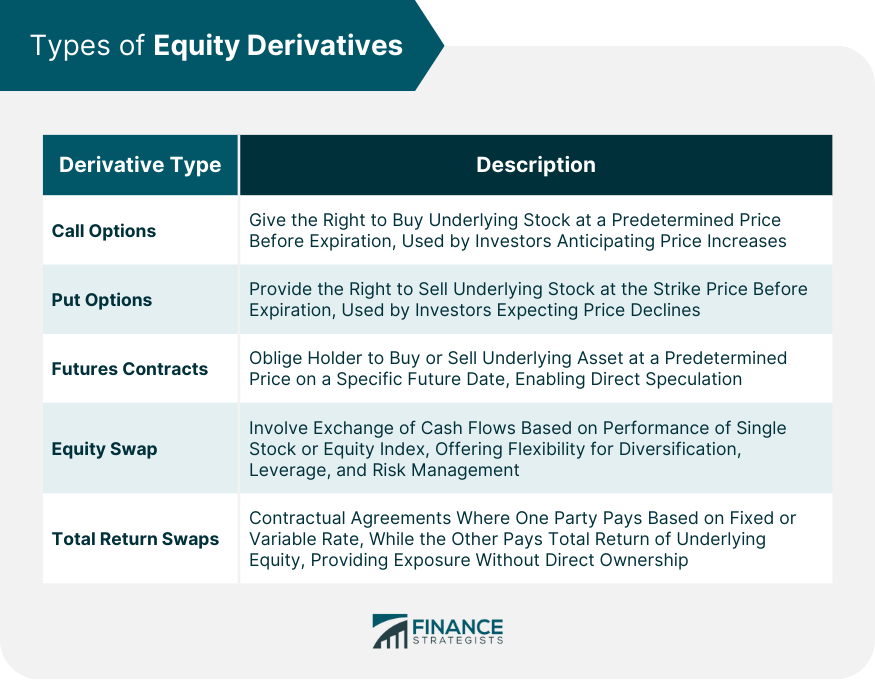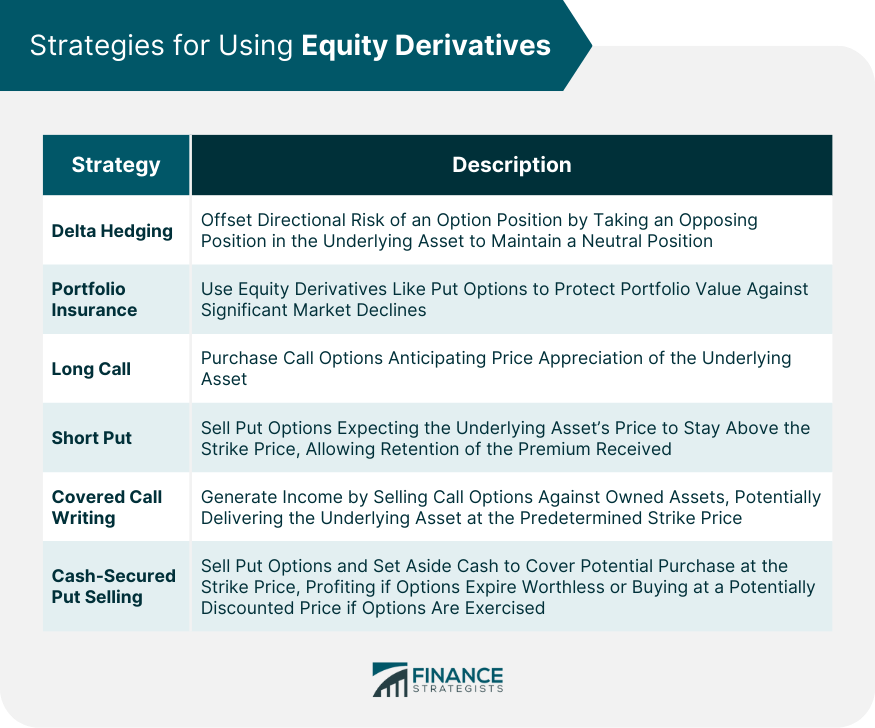Equity derivatives are financial instruments that derive their value from underlying equity securities such as stocks or stock indexes. These versatile tools give investors a way to gain exposure to the stock market, without necessarily owning the underlying stocks. They come in various forms, such as options, futures, and swaps, and are used for a wide range of purposes, from speculation and hedging to portfolio diversification. Equity derivatives play a crucial role in wealth management, offering investors a multitude of strategies for achieving their financial objectives. They enable portfolio diversification, risk management, and potential enhanced returns. By using equity derivatives, investors can hedge their portfolio against market volatility, leverage their investments for higher potential returns, and gain exposure to a wide array of underlying assets that might otherwise be inaccessible or too expensive to invest directly. Call options are equity derivatives that give holders the right, but not the obligation, to buy the underlying stock at a predetermined price (strike price) before a set expiration date. They are commonly used by investors expecting a price increase in the underlying asset. Put options, on the other hand, give the holder the right to sell the underlying stock at the strike price before the option's expiration date. Investors who believe the price of the underlying asset will fall often use put options as a way to profit from this anticipated decline. Futures contracts are another type of equity derivative, and they represent an agreement to buy or sell the underlying asset at a predetermined price at a specific date in the future. Unlike options, futures contracts obligate the holder to carry out the transaction, making them a more direct way to speculate on the price movement of the underlying asset. Equity swaps are agreements between two parties to exchange a series of cash flows. One party pays cash flows equal to the performance of a single stock or an equity index, while the other party pays either a fixed or floating cash flow. It is a flexible instrument that can be used for many purposes, including diversification, obtaining leverage, and risk management. Total return swaps are contracts in which one party agrees to make payments based on a set rate, either fixed or variable, while the other party agrees to pay the total return of the underlying equity, including any income and capital gains or losses. This type of equity derivative can be used to gain exposure to a desired asset without having to own it directly. Leverage is one of the key features of equity derivatives. By putting down a small amount of money upfront in the form of a margin, investors can control a significant amount of the underlying asset. This can potentially amplify returns. However, it is a double-edged sword, as losses can also be magnified if the market moves against the investor's position. Equity derivatives are often used for hedging, which is the process of reducing risk. An investor might use equity derivatives to hedge against potential losses in an existing investment. For instance, an investor who owns a large amount of a certain stock might buy a put option on the same stock to protect against a potential drop in its price. Speculation involves taking on risk in the hope of achieving a return. Equity derivatives are well-suited for speculation due to their leverage feature. For example, an investor might buy a call option on a stock if they believe the stock's price will increase. If the price does indeed rise above the strike price of the option, the investor can exercise the option and buy the stock at the lower strike price, thus profiting from the difference. Speculative strategies can yield high returns, but they also carry the risk of significant losses. Equity derivatives can be used as part of a broader risk management strategy. Investors can use them to hedge against market volatility, diversify their portfolios, and manage exposure to specific sectors or industries. By carefully selecting and combining equity derivatives, investors can create a balanced portfolio that aligns with their risk tolerance and financial objectives. Equity derivatives offer diversification benefits by providing exposure to various sectors, asset classes, and geographical markets, mitigating portfolio risk and potentially enhancing returns. This can help reduce overall portfolio risk and potentially increase returns. Equity derivatives offer the potential for enhanced returns due to their inherent leverage. Investors can control a larger amount of the underlying asset with a relatively small initial investment, which can magnify potential gains. However, this also means that losses can be amplified, making it essential to use leverage judiciously and employ prudent risk management strategies. Equity derivatives can be used to mitigate various types of risk, such as market risk, industry risk, and company-specific risk. For example, investors can use options to protect their portfolios against declines in the stock market or hedge their exposure to specific industries or companies. This can help preserve capital and reduce the impact of adverse market events on the investor's wealth. Counterparty risk is the risk that one party in a financial transaction will not fulfill its obligations, leading to a loss for the other party. In equity derivative transactions, counterparty risk can arise if the issuer or the clearinghouse defaults on its obligations. This risk can be managed by carefully selecting counterparties and using well-regulated exchanges and clearinghouses. Market risk refers to the potential for losses due to changes in market conditions, such as interest rates, stock prices, or exchange rates. Equity derivatives are exposed to market risk because their value is tied to the performance of the underlying asset. Investors can manage market risk by diversifying their portfolios and employing risk management strategies like hedging. Liquidity risk is the risk that an investor will not be able to buy or sell an asset quickly enough and at a fair price due to a lack of market participants. Some equity derivatives, especially those with less common or more complex structures, may have limited liquidity. This can make it difficult for investors to exit their positions when needed, potentially leading to losses. To manage liquidity risk, investors should consider trading more liquid equity derivatives and maintain a well-diversified portfolio. Delta hedging is a risk management strategy that involves offsetting the directional risk of an option position by taking an opposing position in the underlying asset. By adjusting the position in the underlying asset, investors can minimize the impact of price movements and maintain a more neutral position. Portfolio insurance is a strategy used to protect the value of a portfolio against significant declines in the market. It involves using equity derivatives, such as put options, to provide downside protection. If the market experiences a downturn, the put options can offset the losses in the portfolio, providing a form of insurance. A long call strategy involves buying call options with the expectation that the price of the underlying asset will rise. If the price increases, the call options gain value, allowing the investor to profit from the price appreciation. A short put strategy involves selling put options with the belief that the price of the underlying asset will remain above the strike price of the options. If the price stays above the strike price, the options expire worthless, and the investor keeps the premium received from selling the options. Covered call writing is an income-generating strategy that involves selling call options against an underlying asset that an investor already owns. By selling the call options, investors can earn premiums, which can enhance the overall returns of the portfolio. If the options are exercised, the investor delivers the underlying asset at the predetermined strike price. Cash-secured put selling is a strategy where investors sell put options and set aside cash to cover the potential purchase of the underlying asset at the strike price. If the options expire worthless, investors keep the premium received. If the options are exercised, investors purchase the underlying asset at a potentially discounted price. Equity derivatives are versatile financial instruments that can be used for a variety of purposes in wealth management. They offer investors the ability to diversify their portfolios, enhance returns, and manage risks. Their features, such as leverage, hedging, and speculation, make them attractive tools for implementing various investment strategies. However, equity derivatives also come with certain risks, such as counterparty risk, market risk, and liquidity risk. It is essential for investors to understand these risks and employ prudent risk management strategies when using equity derivatives in their portfolios. By carefully selecting and combining equity derivatives, investors can create tailored investment strategies that align with their financial objectives and risk tolerance.What Is an Equity Derivative?
Types of Equity Derivatives
Call Options
Put Options
Futures Contracts
Equity Swap
Total Return Swaps

Features of Equity Derivatives
Leverage
Hedging
Speculation
Risk Management
Advantages of Equity Derivatives
Portfolio Diversification
Enhanced Returns
Risk Mitigation
Risks Associated With Equity Derivatives
Counterparty Risk
Market Risk
Liquidity Risk
Strategies for Using Equity Derivatives
Delta Hedging
Portfolio Insurance
Long Call
Short Put
Covered Call Writing
Cash-Secured Put Selling

Final Thoughts
Equity Derivative FAQs
Equity Derivative is a financial instrument whose value is derived from an underlying equity asset, such as stocks, allowing investors to speculate or hedge.
Equity Derivatives include options (call and put), futures contracts, and swaps (equity swaps and total return swaps), offering various ways to trade or manage risk.
Equity Derivatives provide portfolio diversification, potential for enhanced returns, and risk mitigation opportunities, making them valuable tools in wealth management.
Counterparty risk, market risk, and liquidity risk are the primary risks associated with Equity Derivatives, requiring careful assessment and risk management strategies.
Equity Derivatives can be utilized for hedging against market downturns, speculating on price movements, or generating income through strategies like covered call writing or cash-secured put selling.
True Tamplin is a published author, public speaker, CEO of UpDigital, and founder of Finance Strategists.
True is a Certified Educator in Personal Finance (CEPF®), author of The Handy Financial Ratios Guide, a member of the Society for Advancing Business Editing and Writing, contributes to his financial education site, Finance Strategists, and has spoken to various financial communities such as the CFA Institute, as well as university students like his Alma mater, Biola University, where he received a bachelor of science in business and data analytics.
To learn more about True, visit his personal website or view his author profiles on Amazon, Nasdaq and Forbes.















